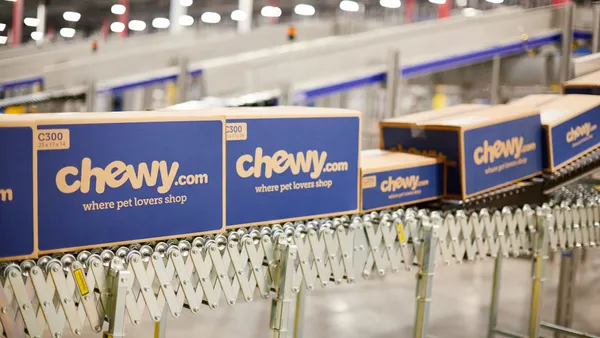Dive Brief:
-
Neiman Marcus Group said Tuesday that fiscal first quarter total revenues fell 7.4% to $1.08 billion from $1.16 billion in the year-ago period amid dwindling traffic, including declines among the upscale department store chain's core customers.
-
Neiman Marcus' same-store sales fell 8% during the quarter, and net losses widened to $23.5 million, compared to Q1 2016 net losses of $10.5 million. The conversion of the company’s legacy merchandising and inventory systems into a single new tech-based system dragged down business in the quarter to the tune of $30 million to $35 million and hit same-store sales by 270 basis points, CEO Karen Katz said on a conference call.
-
Greater price transparency thanks to the internet, the strong dollar, falling profits in the oil and gas sector (affecting the Dallas-based company’s many Texas stores) and new consumer expectations for immediate availability of fashion were also challenges in the quarter, Katz added.
Dive Insight:
It sounds like Neiman Marcus’s first quarter was an expensive one — something the company can ill afford. As it struggles with debt, its options seem to be narrowing, especially as even wealthier shoppers turn away.
There’s not much Neiman Marcus can do about the strong dollar or Texas oil barons' somewhat thinner wallets. But it is working to address two core challenges: 1) The fact that many consumers, including many wealthy customers, are shopping according to price and 2) The fact that many shoppers want to see new fashions in stores immediately upon viewing them on the runway or in fashion magazines.
“The customer has changed the way they shop in several fundamental ways,” Katz said Tuesday. “One is driven by price transparency and the other is what we call ‘buy now, wear now.’ Besides being a treasure trove of merchandise, the internet gives customers greater access to information about price and promotion. They continue to shop for the best deal and the lowest price with less regard for loyalty, channel or brand.”
Consumers no longer have patience for stores to dictate what they get to buy and when, Katz added. “[Shoppers] want to buy something and wear it immediately, rather than waiting for the trends and latest fashion to hit the stores months later or when the weather turns,” she said. “Customers now are less likely to buy a winter coat in summer or sandals in the dead of winter.”
To address these challenges, Neiman Marcus is working to introduce more exclusive product in stores and online and is “working with our vendors to think differently about when they are shipping goods as well as which types of goods are being shipped at different points during the season," Katz said. "More progress will be evident in the seasons ahead.”
But Neiman Marcus is badly hobbled by debt and may find it difficult to turn things around, according to Neil Saunders, CEO of retail research agency and consulting firm Conlumino.
“In our view, such a debt burden is completely unsustainable for a company of Neiman Marcus’ scale,” Saunders said in a note emailed to Retail Dive. “Indeed, even if all interest was frozen and the entirety of operating profit was to be directed to the purpose of paying down the debt, it would take well over 40 years to remove it from the balance sheet. Such a position underlines the fragile nature of the company’s finances, something that hits home when the $72 million quarterly interest payments are appreciated. This acts as a major barrier to the company being sold and makes an IPO far less attractive. It also guarantees that without a significant rise in sales, the company will remain loss making.”
The current retail landscape is not a good setting for a department store that caters to the highly affluent or even the somewhat affluent, Saunders said. Plus, luxury brands that for decades enjoyed a mutually beneficial relationship with department stores are increasingly shunning them in favor of other channels, deleting yet one more reason to visit a tony department store.
“Generating that increase in sales will be extremely challenging given that there are host of pressures acting as a brake on retail growth,” Saunders said. “Weaker traffic in malls and weaker tourist spending are foremost among these, and both are likely to persist well into next year. The rise of direct selling by luxury brands is also a negative trend for Neiman Marcus and, longer term, has the potential to undermine its reason for existence as a destination for high-end product.”
Affluent but not super-affluent consumers, while not quite Neiman Marcus’ (or sibling Bergdorf Goodman’s) core customer, are also falling off in sufficient numbers to hurt results. That they're less willing to pay top dollar at an exclusive department store bodes ill for the future, according to Saunders.
“Against this trend Neiman Marcus has become a rather expensive niche player; in our view if it does not remedy this it will become an increasingly irrelevant player as well,” he said. “Neiman Marcus invests a lot in its stores, in customer service, and in its omnichannel offer. However, these things amount to very little if consumers are not willing to bear the prices charged, or can find the product elsewhere. In short the company now needs to rebuild its relevance.”














